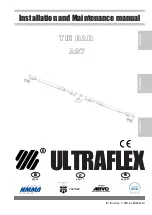
44
UTD.123.2019-10.00_EN
Generally, it is recommended to machine the hole of parts keyed onto shaft end, tolerance
H7
. For high speed
shaft end with D
>
55mm tolerance can be
G7
, progided that load is uniform and light.
For low speed shaft with D
<
180 tolerance must be
K7
, provided that load is not uniform and light.
Before mounting, thoroughly clean mating surfaces and lubricate against seizure and fretting corrosion.
Attention!
Installation and removal operations should be carried out with the aid of jacking screws and
pullers using the tapped hole at the shaft butt-end (see table in fig. 2) taking care to avoid impacts and
shocks which may irreparably damage the bearings, the circlips or other parts or cause sparks; for H7/m6
and K7/j6 fits it is advisable that the part to be keyed is preheated to a temperature of 80
÷
100 °C.
The couplings having a tip speed on external diameter up to 20 m/s must be statically balanced; for higher
tip speeds they must be dynamically balanced.
Where the transmission link between gear reducer and machine or motor generates shaft end loads, ensure
that: loads do not rise above catalogue values:
– loads do not rise above catalog values and values of application design;
– transmission overhang is kept to a minimum;
drive-chains should not be tensioned (if necessary – alternating loads and/or motion – foresee suitable
chain tighteners); if the peripheral speed of the chain is greater than 1 m/s it is necessary to install proper
malfunction markers such as aligning sensors, etc.
– in the gear transmission there is an adequate gear mesh (
≈
0,03
÷
0,04 · m) between pinion and rack
(bushing).
– drive-belts should not be over-tensioned.
Use belts with electric bleeder resistance to mass
<
10
9
Ω
For splined couplings apply adequate products against oxydation.
Incorrect
Correct















































